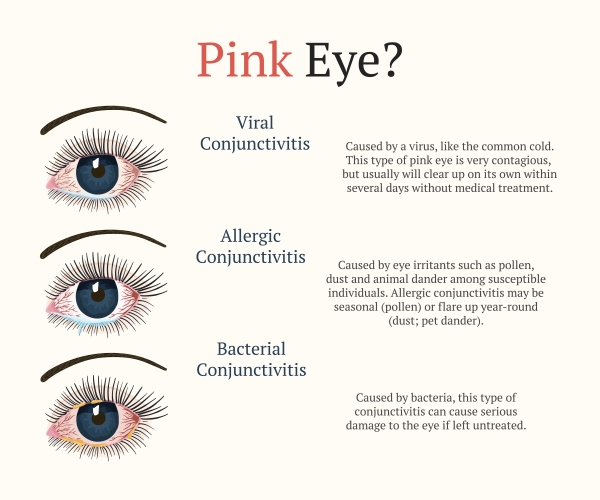
Conjunctivitis (commonly called “pink eye”) is an inflammation of the conjunctiva (the outermost layer of the eye and the inner surface of the eyelids). It is most commonly due to an allergic reaction or an infection (usually viral, but sometimes bacterial).
Redness, irritation and watering of the eyes are symptoms common to all forms of conjunctivitis.
Acute allergic conjunctivitis is typically itchy, sometimes distressingly so, and often involves some lid swelling. Chronic allergy often causes just itch or irritation.
Viral conjunctivitis is often associated with an infection of the upper respiratory tract, a common cold, and/or a sore throat. Its symptoms include watery discharge and variable itch. The infection usually begins with one eye, but may spread easily to the other.
Bacterial conjunctivitis causes marked grittiness/irritation and a stringy, opaque, grey or yellowish mucopurulent discharge that may cause the lids to stick together (matting), especially after sleeping.
Treatment
Conjunctivitis sometimes requires eye care treatment. The appropriate treatment depends on the cause of the problem. For the allergic type, artificial tears sometimes relieve discomfort in mild cases. In more severe cases, non-steroidal anti-inflammatory medications and antihistamines may be prescribed. Some patients with persistent allergic conjunctivitis may also require topical steroid drops.
Bacterial
Bacterial conjunctivitis usually resolves with no treatment. Treatment with antibiotic eye drops or ointments does however speed recovery.
Viral
Although there is no specific treatment for viral conjunctivitis, symptomatic relief may be achieved with warm compresses and artificial tears. For the worst cases, topical corticosteroid drops may be prescribed to reduce the discomfort from inflammation. However prolonged usage of corticosteroid drops increases the risk of side effects. Antibiotic drops may also be used for treatment of complementary infections. Patients are often advised to avoid touching their eyes or sharing towels and washcloths. Viral conjunctivitis usually resolves within 3 weeks. However, in worse cases it may take over a month.
Chemical
Conjunctivitis due to burns, toxic and chemical require careful wash-out with saline, especially beneath the lids, and may require topical steroids. The more acute chemical injuries are medical emergencies, particularly alkali burns, which can lead to severe scarring, and intraocular damage. Fortunately, such injuries are uncommon.

